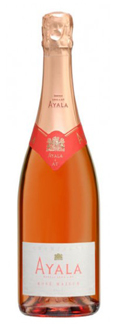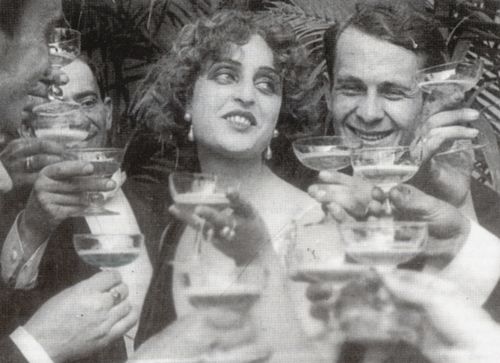Pretty in Pink: Rosé Champagne
/I’d never seen so many open bottles of champagne. Two tables groaned under the weight of 60 deep-bunted bottles of Mumm, Taittinger, Moët, and their brethren in the upstairs dining room of Felidia, where the Wine Media Guild was having its annual champagne lunch. Ed McCarthy, known to some as “Mr. Champagne”, to the twittersphere as @EdChampagne, and to the rest of the world as coauthor of Wine for Dummies (with Mary Ewing-Mulligan), had brought 15 labels of rosé champagne, which ranged in price from $48 (Ayala Brut Rosé) to $300 (Perrier-Jouët Cuvé Belle Epoque Rosé).
It was my first time attending this event, by far the most popular of our monthly gatherings. Why had I been MIA for so long? Indifference, for one. Like professional sports and country music, champagne is a world I’d blissfully ignored for most of my life. It was out of my price range, and there were too many other temptations tugging at my hem.
Second, my piemontese husband has a visceral aversion to champagne. “It’s dirty water,” he says when asked to explain his antipathy. I remind him that’s the same phrase he uses to describe American coffee (which makes sense relative to espresso. But champagne?). “In Italian, ‘dirty water’ means something that’s useless,” he replies. I press further, and he offers a dozen variations of “they charge too much.” When I finally get him to cede that—price aside—he might like some champagne, his conditions are severe: only full-throttle, toasty-yeasty versions. Fair enough.
Personally, I had my champagne epiphany at a Society of Wine Educators conference two years ago, when nonvintage champagne was featured at a luncheon. Presenting it was none other than Ed McCarthy, who cogently laid out the styles of NV champagne, from light to full-bodied, as we tasted Ayala (representing the Brut 0 movement), Henriot, Mumm, Charles Heidsieck (voted the group favorite), Roederer, and Gosset.
 This month’s rosé champagne tasting featured many of the same names. Once again, AYALA was among my favorites. Its NV Extra Brut rosé was light bodied, with zesty pink grapefruit flavors and toasty yeast; and at $48–$54, it was the room’s best buy. ALFRED GRATIEN Brut Rosé was another standout ($62–$75). “It’s not a household name,” McCarthy noted of this traditional old house, but its tart fruit sung in beautiful harmony with the risotto with champagne, salmon, and lobster we were scarfing down. I also loved the full-flavored GOSSET NV Brut Rosé ($70–$80), a mouthwatering marriage of pink citrus and toast (sounds like brunch!), as well as the LOUIS ROEDERER 2007 Brut Rosé ($65–$70).
This month’s rosé champagne tasting featured many of the same names. Once again, AYALA was among my favorites. Its NV Extra Brut rosé was light bodied, with zesty pink grapefruit flavors and toasty yeast; and at $48–$54, it was the room’s best buy. ALFRED GRATIEN Brut Rosé was another standout ($62–$75). “It’s not a household name,” McCarthy noted of this traditional old house, but its tart fruit sung in beautiful harmony with the risotto with champagne, salmon, and lobster we were scarfing down. I also loved the full-flavored GOSSET NV Brut Rosé ($70–$80), a mouthwatering marriage of pink citrus and toast (sounds like brunch!), as well as the LOUIS ROEDERER 2007 Brut Rosé ($65–$70).
 But for me, the died-and-went-to-heaven champagne was NICOLAS FEUILLATTE’s 2004 Palmes d’Or Rosé. I kept circling back to this prestige cuvée, savoring its distinctive floral character—redolent of rose petal and fresh apricot—so different from the rest. It was like a rare orchid amidst the daisies. (This was the only one made from 100 percent pinot noir, so that explains a lot.) But at $180–$200, it was mine to enjoy only then and there. Santa will certainly be keeping this one for himself.
But for me, the died-and-went-to-heaven champagne was NICOLAS FEUILLATTE’s 2004 Palmes d’Or Rosé. I kept circling back to this prestige cuvée, savoring its distinctive floral character—redolent of rose petal and fresh apricot—so different from the rest. It was like a rare orchid amidst the daisies. (This was the only one made from 100 percent pinot noir, so that explains a lot.) But at $180–$200, it was mine to enjoy only then and there. Santa will certainly be keeping this one for himself.
Between courses, McCarthy noted how, after being an afterthought for decades, rosé champagne is now ‘in’, accounting for 8 percent of all champagne. Its prices tend to be higher, since the winemaking process for red grapes is more laborious and maintaining the same shade of pink each year involves sheer wizardry by each house. But the pinot noir at its core makes for fuller bodied wines. “So it goes especially well with food,” McCarthy said as we gave the thumbs up when waiters wheeled out a cart holding an awesome roasted salmon—26-pounds and a yard long—stuffed with lemon slices and sprinkled with crunchy sea salt. (Bless you, Felidia.)
During lunch, WMG member and champagne maven Cynthia Sin-Yi Cheng gave Ed McCarthy a pop quiz. To wit:
Favorite champagne style? Vintage blanc de blanc
Favorite vintages: 2002, 1996, 1988, 1964
Favorite place to drink champagne: Anytime with friends—especially if they’re in Paris.
Preferred food pairings: Mushroom dishes, especially pastas with mushrooms
Most memorable champagnes: 1928 Krug, and 1988 and 1996 Louis Roederer Cristal
Fair enough. My memorable champagne moments are now two, and both involve Ed McCarthy. Thanks for that, Ed!





